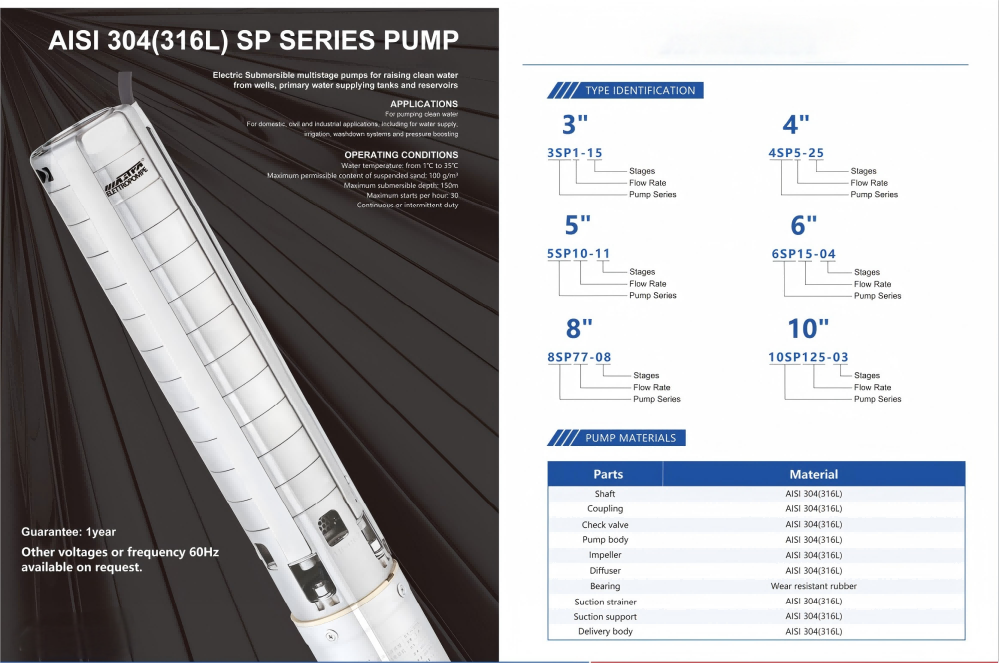Stainless steel deep well pumps: Efficient and durable deep well water intake solutions | depth analysis and selection guide
Why choose stainless steel deep well pump? Analysis of five core advantages?
In agricultural irrigation, industrial water supply or domestic water use scenarios, stainless steel deep well pumps are the preferred equipment for users worldwide due to their superior performance. Compared with traditional cast iron pumps, its advantages are:
Super corrosion resistance
Using 304/316 stainless steel, it can resist chloride ions, sulfides and acid and alkali substances in groundwater, extending life by 3-5 times (data source: International Pump Association research).
Deep water intake capacity
Designed for Wells between 50 and 300 meters deep, the multi-layer impeller structure ensures stable head and can meet the pumping needs of Wells up to 500 meters deep in extreme cases.
Energy saving and environmental protection
Equipped with efficient permanent magnet motor, energy consumption is 35% lower than traditional models, in line with EU ERP energy efficiency standards.
Low maintenance cost
Integrated sealing technology prevents sediment intrusion, bearing life of more than 20,000 hours, reducing downtime maintenance frequency.
Multifunctional adaptation
Support frequency conversion control, flow adjustable range up to 30%-120%, suitable for irrigation, fire fighting, mine drainage and other multiple scenarios.
Detailed explanation of technical parameters of stainless steel deep well pump (with industry standard comparison table)
How to select correctly? 3 steps to accurately match requirements
Step 1: Define the usage scenario
Agricultural irrigation: High flow models are preferred (e.g. QDX series)
Urban water supply: Choose low noise frequency pump (QJ series recommended)
Industrial cooling: need to be equipped with high temperature version (+80℃ special design)
Step 2: Calculate key parameters
Flow demand = daily water consumption ÷ running time × safety factor (1.2-1.5)
Head calculation = depth of static water level + pipeline loss + outlet pressure demand
Example: 200 m deep well, target flow 30m³/h, pipeline loss calculated at 10% → total lift =200+20+5=225 m
Step 3: Verification of certification standards
Verify that the product is CE, UL or CSA certified
Check motor insulation level (recommended Class F or above)
Third party test report required (focus on cavitation margin NPSH value)
TOP5 application scenarios and successful cases in the world

Agricultural projects in Saudi Arabia
In a groundwater environment with a salt content of 8%, the 316L stainless steel pump has been running for 5 years without failure.
Canadian polar research station
Stable water supply at -30℃.
Palm oil plantations in Indonesia
A single pump system covers 2,000 hectares of irrigation, reducing energy costs by 42%.
The Golden Rule of Maintenance (The secret to 50% longer life)
Quarterly inspection: Test motor insulation resistance with megohm meter (should be > 50MΩ)
Annual maintenance:
① Remove calcified deposits from the pump body (5% citric acid solution is recommended)
② Replace the mechanical seal (even if it is not damaged, preventive replacement is needed)
Emergency handling:
→ Sudden drop in flow: Check the filter and check valve
→ Abnormal vibration: Stop the machine immediately to check the bearing status
Industry Trends and technological Innovation in 2024
Intelligent iot upgrade: Support APP remote monitoring (real-time view of voltage, flow, fault code)
New material breakthrough: Ceramic-coated impellers reduce wear rate to 0.01mm/ 1000 hours
Green manufacturing: 85% of components can be recycled, reducing carbon footprint by 60% (according to a new report in WaterTech magazine)
Call to action:
Looking for a durable deep well pump solution? Get a free selection solution now → Click Contact Engineer(Whatsapp:+86 17856275957)
Or download "Deep Well Pump Selection White Paper" : Download PDF now

